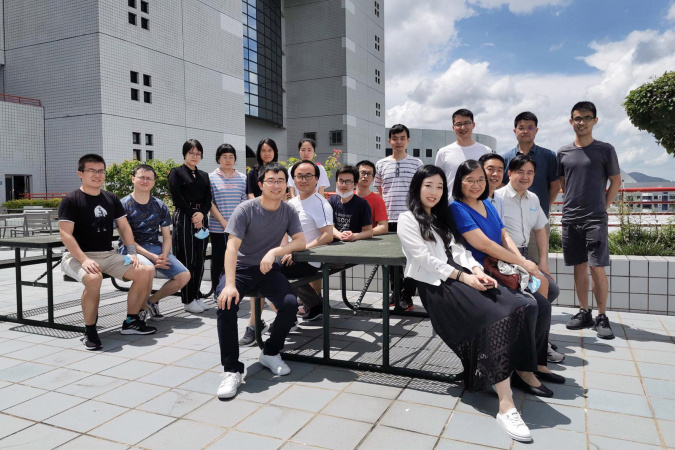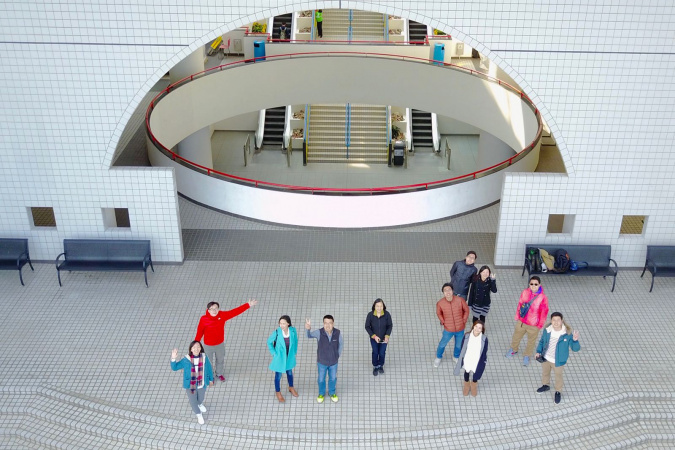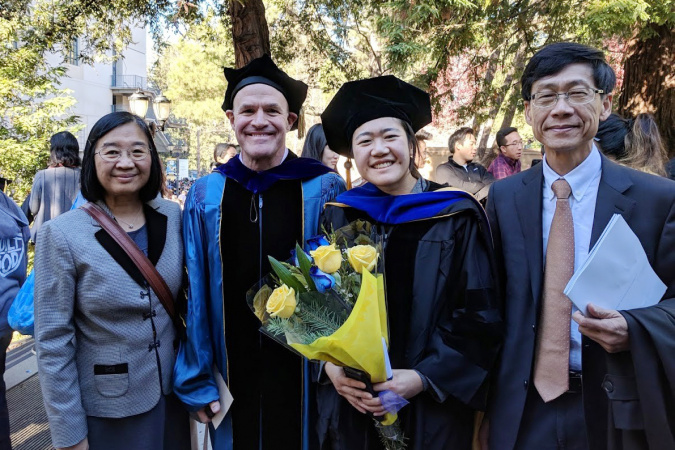Prof. Kei May LAU Shares her Approach to Life and Research
The next time you switch on the lights, consider this: powering traditional lights consumes about 20% of the electricity that we produce. For more than 20 years, Prof. Kei May LAU, Chair Professor of Electronic and Computer Engineering, has been one of the early contributors to the research of LED technology, a revolutionary energy-efficient and environmentally friendly alternative. In recognition of her fundamental contribution to research on compound semiconductor materials and device physics, she was awarded the Institution of Engineering and Technology’s J. J. Thomson Medal for Electronics, becoming the first woman to receive the honor in its 44-year history. She shares with us her life experiences as a researcher, female engineer, teacher, and mother.
“Choosing a research topic to focus on is a bit like predicting the future. Some predictions come through, many others don’t,” Prof. Lau says. “When conducting engineering research, we want to do something people care about and that will pan out; the most challenging part is coming up with visionary ideas. The timing of getting into a new topic is critical as well.”
While light-emitting diodes (LEDs) for lighting are ubiquitous today, in the 1990s when Prof. Lau started researching the subject, it was a novel area. Engineers at the time were excited about LEDs’ tremendous power-saving potential – they consume less electricity and do not emit heat. In addition, they contain no toxic elements such as mercury in fluorescent lights. “I bought into the idea as I thought it made sense,” Prof. Lau recalls. “You can say my timing was good.”
Once LEDs for lighting caught on in the market, Prof. Lau moved on to focusing on miniaturizing them. She has developed high-resolution fingernail-sized LED micro-display chips, that could be used to build three-in-one traffic lights or virtual windows, among other applications such as in AR (augmented reality) and VR (virtual reality) displays.
The near-to-eye micro-display she developed can be stuck on a pair of glasses and connected to a camera to offer a rear view. She reveals that the idea came from her experience of navigating the narrow pavements of Hong Kong.
“Usually, two people have to walk one after another on our busy and narrow streets. Often, I’d lose the people I was with. It inspired me to try and create ‘an eye’ to keep track of the people behind me,” she says with a laugh.
Early years and coming home
Prof. Lau says she takes a hands-on approach to her work. “I love to see things work, instead of solving equations or building models using stimulations,” she says. “Models give some guidelines but don’t tell the whole story and make things. Unlike the scientists’ role in discovering the nature, engineers create things to benefit humanity, balancing performance and the cost of our design.”
After graduating from Pui Ching Middle School, she went overseas and earned a Bachelor of Science and Master of Science in physics from University of Minnesota, Minneapolis, before going on to pursue a PhD in electrical engineering at Rice University in Houston, Texas.
She says the PhD in electrical engineering was a natural progression from studying physics. “Electronic engineering research is mostly based on physics. Pure science is the human understanding of nature, while engineering adapts the laws of physics defined by nature to create something new and useful, like the mobile phone.
Prof. Lau’s HKUST journey began in 1998 when she came to the University as a visiting professor and was very impressed – not least by the beautiful scenery. Two years later, she left the full professorship she held at the University of Massachusetts Amherst and joined HKUST’s regular faculty.
After many years of living in the United States, it felt like a homecoming. “I am a Hongkonger. I was born and raised here, and always wanted to return to my roots. Also, I hoped my daughter could grow up in a rich multi-faceted bilingual and bicultural environment,” she says.
Scrambled egg approach to life
Prof. Lau is often asked about work-life balance and how she manages her time. “Many people’s lives are like fried eggs – the yolk is their private life while the white is work. My life is a scrambled egg; there is no distinction between the two.” Over the years, she has developed a ‘firefighting’ approach allowing her to juggle and meet deadlines, personal and professional commitments anytime anywhere.
As a prominent woman engineer, Prof. Lau says she has never let her gender limit her aspirations. “Perhaps my personality of not caring too much about others’ opinion on what I should or should not do helps,” she says. “For young women who dream of being successful professionals, deciding on their own destiny matters the most.”
She believes that the main reason for the lower proportion of women in engineering programs is that most outstanding girls have a plethora of options. “They can choose either arts, business, science, medicine or any disciplines according to their interests, and they can excel in any of these areas; or they get ‘pushed’ into areas deemed more financially rewarding by family,” she muses.
She says she only offers advice but does not tell youngsters what they can/should and cannot/should not do. “Like myself, when eighteen-year-olds were undecided about what subject to choose at university, I suggested they get into engineering because it provides vigorous training in problem solving with analytical skills. They could just shift direction once they find their preference later, basically do anything they want. I also cited some examples from our circle.”
‘Don’t rush, but be quick’
Prof. Lau firmly believes that innovation and experience are an intrinsic element of technology breakthroughs. “I always tell students that connectivity is the most important attribute. When students complain that what they learn in some courses is not useful, I would say that it is not that the course is useless, but that they have yet to figure out how to link up the newly acquired information with their experience and knowledge.”
Her teaching philosophy is to adapt her approach to the student’s aptitude and personality. Some are more proactive, and some require more guidance and encouragement. She applies this philosophy to postgraduate students who she works with one on one, pointing out that Confucius says: “Teach students according to their aptitude” (因材施教).
Prof. Lau has adopted a seemingly paradoxical Cantonese idiom as the motto for her laboratory: don’t rush, but be quick (唔使急, 最緊要快). “Doing research is just like taking part in a marathon. You can’t rush as you have to think ahead carefully, conduct experiments meticulously and obtain reproducible results, but you also need to be quick so that you are the first to report the results in the competitive arena.”
Keeping the lights on
In her own career, Prof. Lau’s research instincts have paid off. The J. J. Thomson Medal is the latest in a long list of honors she has received over the years. She is an IEEE Fellow and an OSA Fellow as well as a recipient of the OSA Nick Holonyak Jr. Award, IEEE Photonics Society Aron Kressel Award, and US National Science Foundation (NSF) Faculty Award for Women Scientists and Engineers.
“I am proud of every single award,” she says. “They are all recognitions of significant contributions from researchers in my group over the years. That our fruitful results have been appreciated by our peers is very satisfying.”
She is not content to rest on her laurels though, emphasizing that there are still many problems to be solved. She is currently focusing on the integration of electronics and photonics.
“A vast amount of data needs to be transmitted and processed swiftly and efficiently at any instance; the smaller the electronic circuits are, the quicker the signal passes. Transistors can now be fabricated as small as a few nanometers. Light (photons) in integrated circuits could help speed up data transmission much further. How to enhance the performance of semiconductor photonic integrated circuits? This is what we are now researching, and it is a never-ending task.”
Motivated by a powerful desire to explore and illuminate new paths in integrating photonics and microelectronics, Prof. Lau will remain a beacon for generations of the engineering community. “The most rewarding part is seeing the success of former students and sharing our lifelong friendship,” she says.
Related Links:
- SENG news (Nov 6, 2020): Prof. Kei May LAU Became the First-Ever Woman Recipient of IET J. J. Thomson Medal for Electronics
- IET press release (Nov 6, 2020): World leading engineers win IET Achievement Awards
- HKUST Photonics Technology Center
- Wen Wei Po news (Mar 8, 2021): 女科學家捱過歧視終奪獎
- Wen Wei Po news (Mar 8, 2021): 「工程人人可做,勿放自己入框框」




